Britain's best chefs: Seven regional restaurants, seven brilliant local recipes
From Cornwall to Edinburgh, we scoured the country to ask seven restaurants to show that fine dining is thriving beyond London. The result: passionate words, behind-the-scenes pictures and truly mouth-watering recipes from some of this island's most exciting chefs
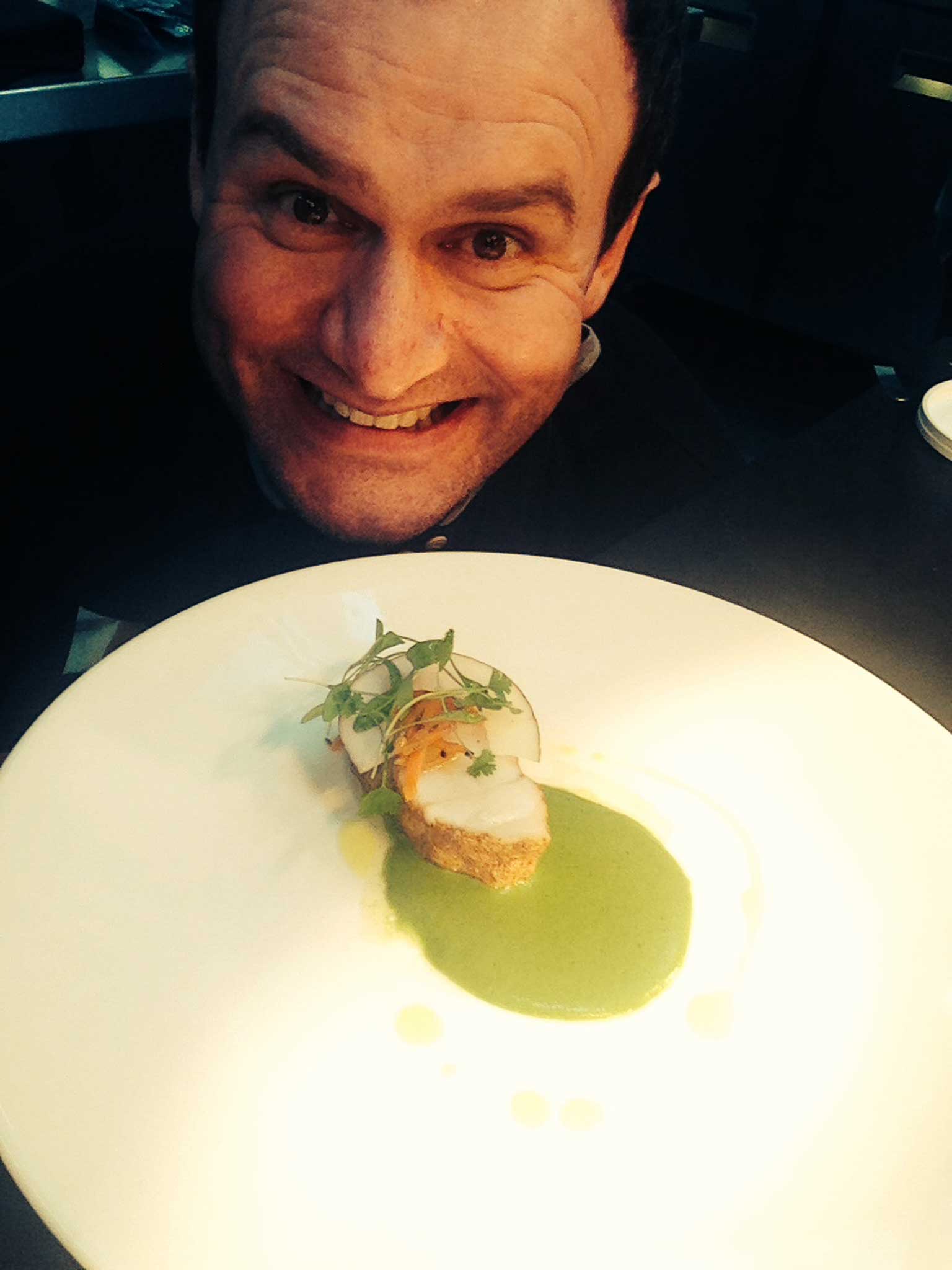
THE MIDLANDS
PURNELL'S
Masala spiced-monkfish with red lentils, pickled carrots and coconut cream
"The masala monkfish is one of my signature dishes and went on to be successful on The Great British Menu," says Birmingham chef Glynn Purnell. "It uses cooking techniques that ensure the meaty fish retains moisture, soaking up the full flavour of the spices.
"Birmingham has evolved from being a culinary desert to an exciting destination buzzing with multicultural communities who showcase a vast array of flavours and cuisines.
"This dish transports me back to my childhood, fond memories of times spent with my parents and siblings at our favourite curry house, The Falcon in Ward End. As a budding chef, one of my earliest childhood memories is serving curried beans on toast to my family when I was eight."
Serves 4
For the monkfish
4-5 tbsp salt
4 x 100g monkfish fillets
25g butter
For the masala spice mix
¼ cinnamon stick
2 tsp fenugreek seeds
½ tsp fennel seeds
1½ tsp black mustard seeds
5 cloves
1 tsp coriander seeds
1½ tsp cumin seeds
Preheat the oven to 50C/120F. Sprinkle the salt over the monkfish fillets and leave for 5 to 6 minutes to remove moisture. Wash the salt off thoroughly under cold running water. Wrap the washed monkfish in a clean tea towel and leave overnight in the fridge.
For the masala spice mix, place all of the ingredients into a food processor and blend to a powder. Transfer to a plate then roll the monkfish pieces in the mixture. Seal each monkfish fillet in a vacuum-pack bag and cook for 11 minutes in a water bath at 63C/145F.
Melt the butter in a frying pan until foaming. Remove the fish from the bags, then sear on both sides for 2 to 3 minutes or until golden-brown and crisp all over.
We serve the monkfish with red lentils, pickled carrots and coconut cream. Pour coconut milk into a pan and add a pinch of salt. Simmer for 15 to 20 minutes, or until reduced by half. Now heat a frying pan and toast thinly sliced coconut strips until golden-brown and fragrant.
To serve, place the monkfish on a plate then garnish with the toasted coconut, pickled carrots and fresh coriander shoots. Drizzle over a bit of the reduced coconut milk, spoon the lentils in to a balti dish on the side and serve.
WALES
THE WALNUT TREE
"The Walnut Tree [near Abergavenny] has been much loved for more than 40 years," says chef-patron Shaun Hill. "Its early incarnation was as one of the country's finest Italian restaurants, under Franco and Ann Taruschio. When they retired, the place fell on harder times and, after a misconceived appearance as one of Gordon Ramsay's kitchen nightmares, eventually closed down. I had been a frequent diner and admirer of the place and thought to try to resurrect it. The setting on the edge of the Brecon Beacons is attractive, but then almost all the Welsh countryside is magnificent.
"The restaurant reflects my own values as far as eating is concerned. The idea is that the menu should be an extension of the day's shopping, qualified by the tastes and craft skills of the kitchen. My view is that food should taste good and have some integrity as far as its provenance is concerned.
"It irritates me sometimes that my food is described purely as 'simple'. It takes eight of us all day to make food this simple. Unelaborated dishes have no safety net of a 'wow' factor, no pine-needle smoke nor recently foraged seaweed. They survive, as does the restaurant, on how well, and how carefully, they are made."
Buttermilk pudding with cardamom strawberries
Cultured buttermilk has a flavour similar to yoghurt. This dessert is light and should be refreshing rather than sickly sweet.
Serves 6
For the Pudding
200ml double cream
250g caster sugar
1 vanilla pod, split
4 strips orange peel
Juice ½ lemon
3 leaves gelatine, soaked in cold water
600ml buttermilk
200ml whipped cream
For the strawberries
1 large punnet strawberries
1 tbsp caster sugar
1 tsp crushed cardamom seeds
Juice 1 orange
1 tbsp clear honey
Halve the strawberries. Heat the other ingredients then spoon over the strawberries. Serve with the buttermilk pudding.
THE SOUTH-EAST
THE SPORTSMAN
"The Sportsman is set on a stretch of marshland on the north Kent coast. The location is either bleak and ugly or bleak and romantic, depending on your taste," says Stephen Harris, chef-patron at this Whitstable establishment.
"The remarkable thing about this small stretch of coast is that it was the larder for the monks of Canterbury back in the Middle Ages. The marshland made salt production possible and the local farm is still named Monkshill 900 years later. The farm provides us with lamb, pork, chickens, ducks, fruit and veg, and the estuary is home to some of the best native oysters in the world.
"This dish sums up what we try to do with a lot of our food, which is to make familiar ingredients more exciting. We have always had great meat, fish, seafood and game but the time has come to put great vegetables at the centre of our dishes. We are about to grow even more of our own veg, so the cabbage will be naturally sweeter for being so fresh."
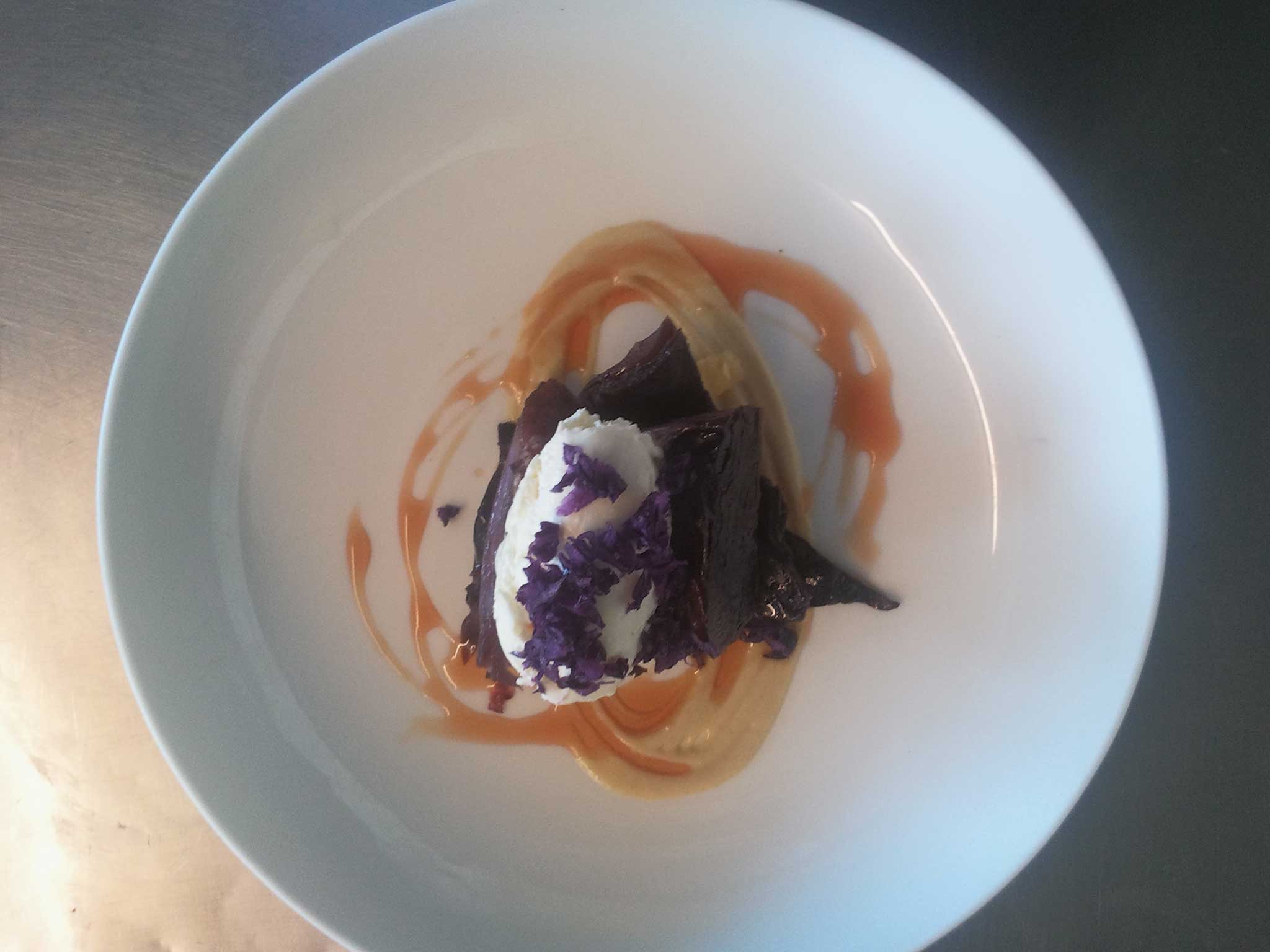
Pot-roast red cabbage, stewed apple and fresh cheese
This dish (pictured above) is made up of five components: pot-roast cabbage, stewed apple, apple balsamic, a mustard dressing, and fresh cheese – though while we make our own at the restaurant, I would just use cream cheese at home.
Serves 4 per half-cabbage
For the cabbage
1 red cabbage
150g butter
Halve the cabbage and cook it very slowly in a heavy cast-iron pan (with the lid on). Add the butter and a good pinch of salt. Turn the cabbage every 30 minutes and check to see if it is cooked with a small knife. It will take about 90 minutes. Leave to cool with the lid on.
For the stewed apple
3 Cox apples
125g butter
Core and dice the apples in half the butter.Cook gently until soft and add the rest of the butter with a pinch of salt.
For the apple vinegar
1 litre Bramley apple juice
50ml cider vinegar
Reduce the juice and vinegar until about 200ml remains. When it cools, it will have a syrupy consistency. Make this in advance.
For the mustard dressing
4 tbsp Dijon mustard
4tbsp red-wine vinegar
8 tbsp neutral oil
Whisk together the vinegar and mustard and then slowly add the oil, as for mayonnaise. Add a pinch of salt. This also makes a good dressing for cooked spring greens.
To Serve
Decorate the plate with the mustard dressing and apple vinegar, then put the stewed apple in the middle. Carve the red cabbage and place a piece on the stewed apple. Top this with cream cheese. For a final touch, we put a bit of raw, grated red cabbage over the dish.
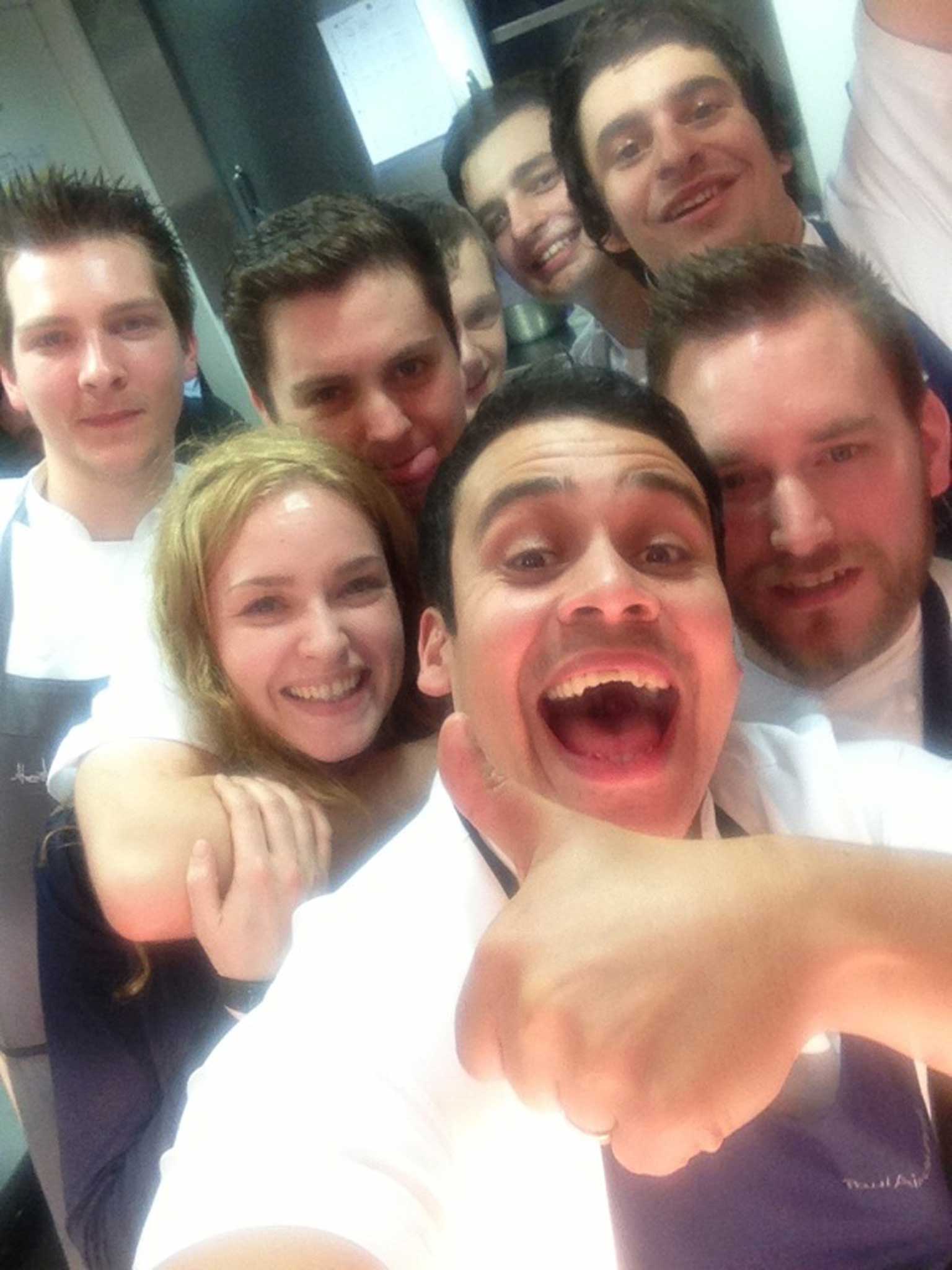
THE SOUTH-WEST
PAUL AINSWORTH AT NO. 6
"Here in Cornwall we have world-class fishermen, amazing farmers and producers literally on our doorstep – we can see half of our suppliers from our windows," says Paul Ainsworth, chef-patron at this Padstow favourite. "This dish really lets the ingredients shine: fantastic crab, beautiful prawns, rocket for pepperiness and fresh, juicy cherry tomatoes for sweetness and texture."
Home-made tagliatelle with tiger prawns and Cornish crab
Serves 4 For the pasta dough
6 egg yolks
4 whole eggs
Smallest pinch of saffron, steeped in 2 tbsp water
550g 00 pasta flour
Salt
5ml olive oil
Whisk the eggs and saffron water until combined. In a food processor, whizz up the flour, salt and oil. Slowly add the egg mixture until a breadcrumb texture forms. Tip this out on to a floury work surface and knead it firmly until you have a soft, glutinous ball of dough – this takes roughly five minutes. Wrap in cling film and leave to rest in the fridge.
For the sauce
200ml vegetable stock
50g butter in cubes
Extra-virgin olive oil
24 shelled and deveined tiger prawns, seasoned
20g garlic purée
Juice of 1 lemon
Handful fresh chives, chopped
12 ripe cherry tomatoes (sliced in half)
To serve
200g white crab meat
40g fresh rocket salad leaves
40g pine nuts (lightly toasted under a grill)
1 red chilli (sliced)
Have a pan full of salted water boiling ready for the pasta. In a separate pan, heat the vegetable stock and whisk in the butter to make an emulsion.
Heat a frying pan until it's really hot, then add a good splash of olive oil. Add the prawns and turn after 30 seconds until they're pink and juicy. Add the garlic purée and a good splash of lemon juice to wake up that delicate flavour. Then add a good 50ml of vegetable emulsion and reduce for about a minute.
Place the pasta in boiling water for 2 to 3 minutes and strain before adding the pasta to the prawn pan. Give it all a really good mix until it's thoroughly combined. Throw in your chopped chives and cherry tomatoes, then give it all a taste to check the seasoning.
To serve, place the pasta in a bowl and pile the fresh white crab meat, rocket pine nuts and chilli over the top. Finish with a splash of lemon juice and oil. Serve with crusty bread.
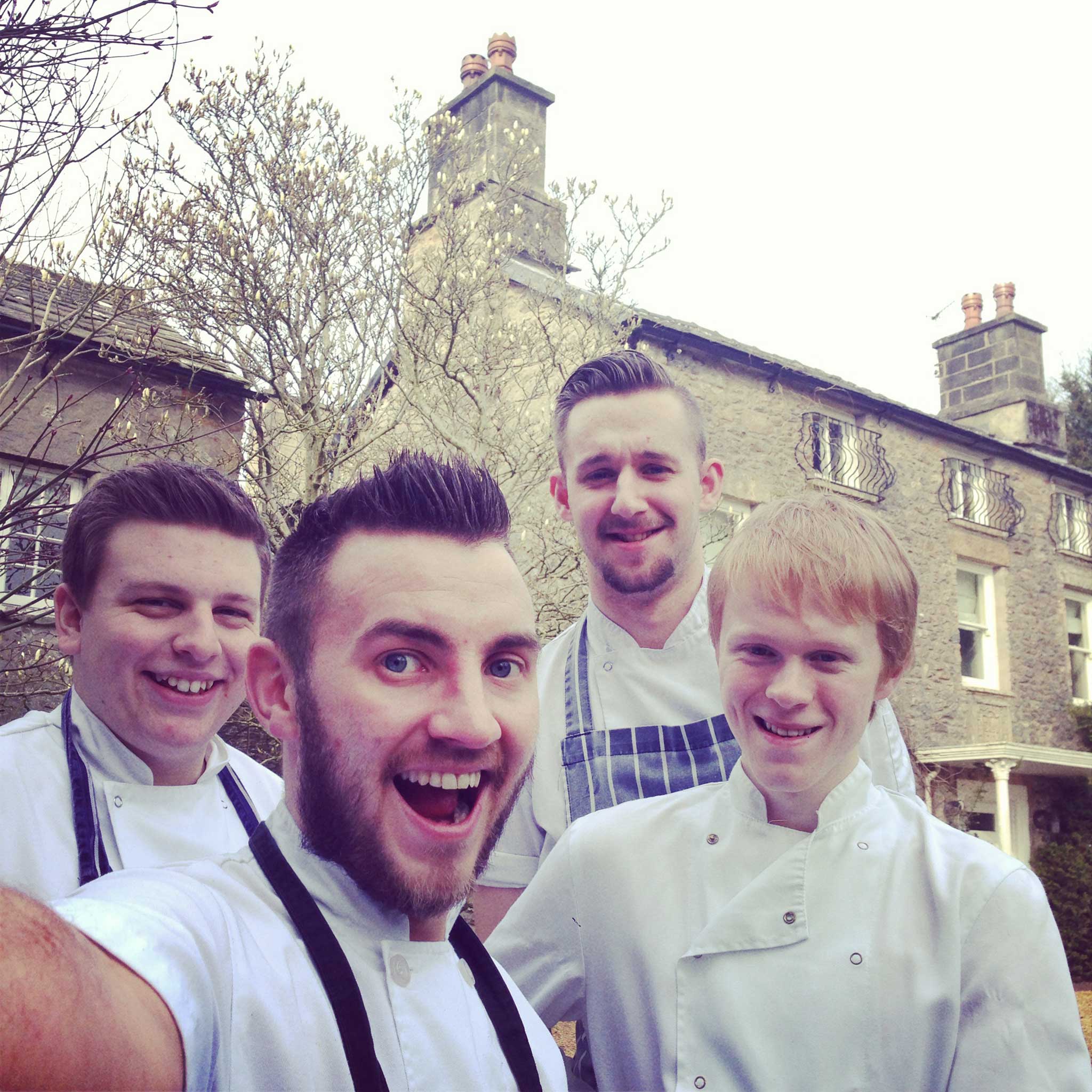
THE NORTH-WEST
HIPPING HALL
"Hipping Hall is a restaurant with rooms in Kirkby Lonsdale, in the northern reaches of Lancashire. And being in the countryside means we are spoilt for choice when it comes to suppliers of great ingredients," says owner Andrew Wildsmith.
"Since we opened nine years ago, there has only been one dish consistently on the menu and that's Stewart Lambert's superb lamb from Kitridding Farm. Stewart farms tough and hardy Swaledales in the hinterland that lies between the Yorkshire Dales and the Lake District. His sheep have to work hard to survive in this often-hostile landscape, imparting extra flavour to their meat.
"We're using two different cuts of lamb in this recipe. (You'll need to prepare a day in advance.) The short loin, an A-grade cut with no fat or sinew; and the belly, a flavoursome piece of meat we have confit'd down. To keep the dish fresh and spring-like, we've paired it with leeks and red onions."
Herb-crumbed roast loin of lamb, confit belly, leek and red onion
Serves 4
4 x 100g lamb loin
225g lamb belly
For the Pickled red Onion
1 red onion
100g white-wine vinegar
2g salt
25g sugar
50ml water
Peel and wash the onion. Slice into quarters and then split into petals. Bring the other ingredients to the boil then remove from the heat and add the petals. Cover with cling film and stand for 3 hours.
For the leek purée
1 leek
25g butter
250ml vegetable stock or water
Salt to taste
Wash and trim then finely slice the leek. Make an emulsion with the butter and veg stock by vigorously whisking them together then bring to the boil. Add the leek and cook for four minutes. Strain the leeks, keeping the emulsion to one side. Blitz the leeks in a food processor, adding the emulsion until the consistency is that of a thick winter soup.
For the herb crumb
30g fresh green herbs (rosemary, parsley, mint)
200g breadcrumbs
Blitz the breadcrumbs and herbs together in a food processor. Dry out in a warm dry place for 24 hours, then blitz again.
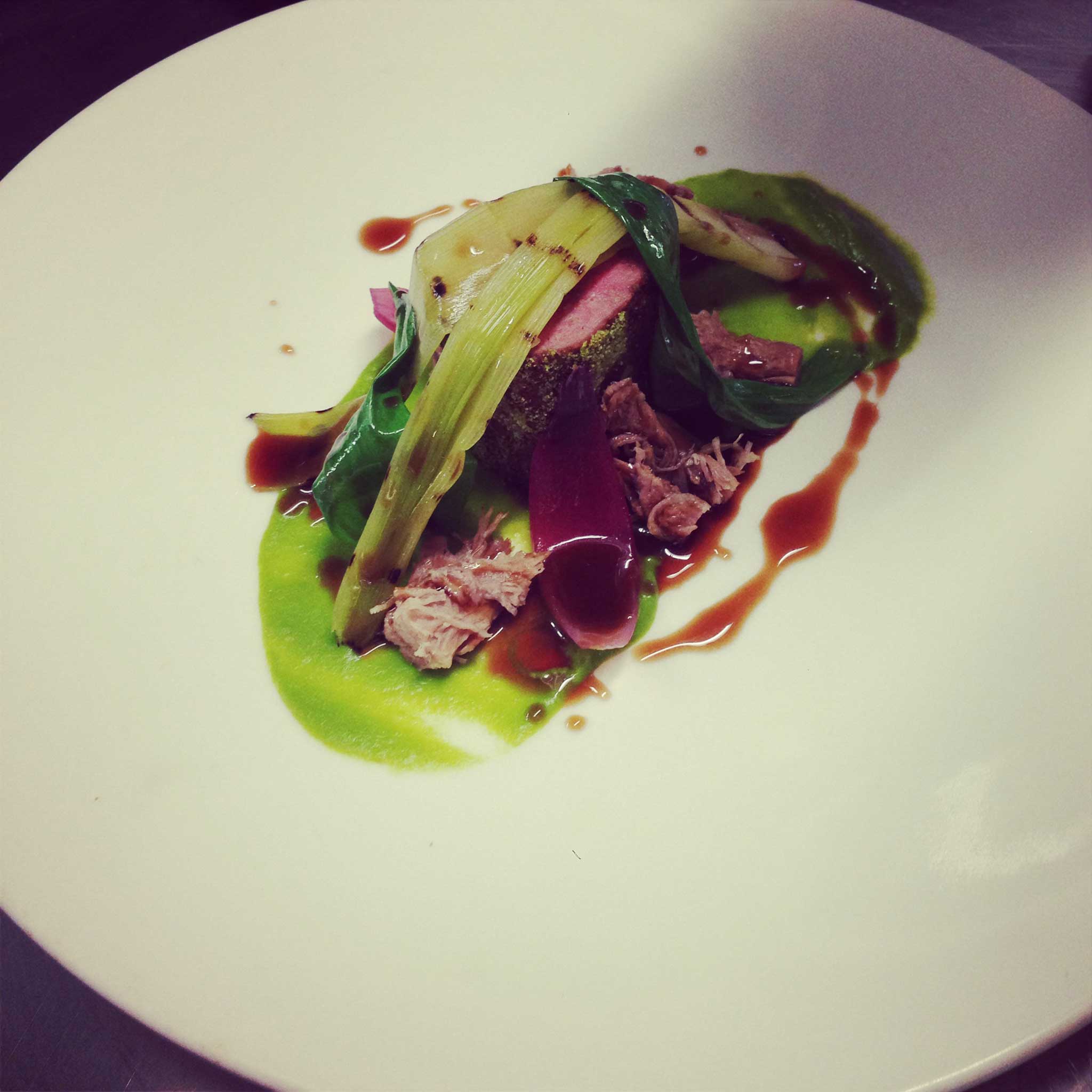
For the lamb loin
Pre-heat the oven to 200C. Cut each loin into three-inch pieces. Sear in vegetable oil for 1 minute on each side then roast for 2 minutes, turn and roast again for another 2 minutes. Rest for 2 minutes in a warm place. Roll in the herb crumb, slice off the ends and serve.
For the lamb belly
Cover the belly in rock salt and finely chopped green herbs. After 24 hours, wash off the salt and pat dry. Cover in duck fat and confit in the oven at 100C for 10 hours. Remove from the fat and allow to cool. When cool, strip off the fat and flake down.
To serve
Arrange the warmed leek purée, lamb loin and onion petals on a warm plate. Flake the confit lamb belly over the top. Serve with a chargrilled baby leek and wilted wild garlic picked fresh from the garden. Finish with lamb sauce or your favourite brand of gravy.
'This dish transports me back to my childhood, fond times spent with my parents and siblings at our favourite curry house'
'Being in the countryside means we are spoilt for choice when it comes to suppliers of great ingredients'
SCOTLAND
THE KITCHIN
"This is a dish that tells a story for me," says Tom Kitchin, chef-patron of this Edinburgh restaurant. "My two eldest sons love to explore and play in the rockpools at the beach, and I used to spend my summer holidays picking around rockpools on the beach near Arisaig on Scotland's west coast. That's the inspiration for this dish. It's a wonderful collection of west-coast shellfish served with sea plantain, samphire and sea aster in a chilled tomato consommé.
"We serve it with a scroll map of Scotland which shows where each element comes from. I wanted to produce something that would be a surprise to eat – like a rockpool itself, with lots of hidden ingredients, so that each bite becomes a discovery.
"You can use any combination of fish, shellfish and seaweed for this recipe. I tend to use what comes in fresh that day, or what my suppliers recommend, but here are some suggestions for you to try."
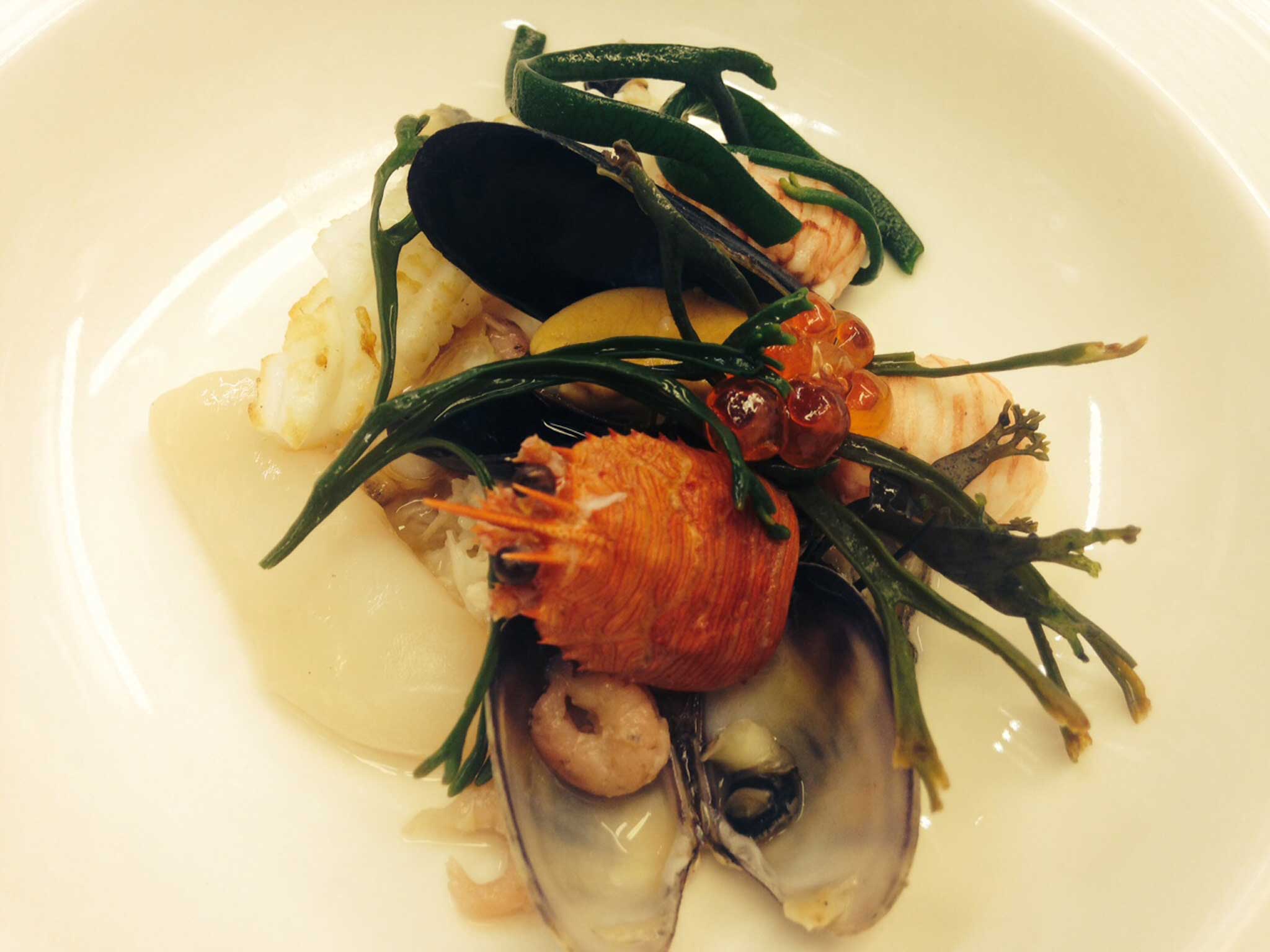
Rockpool
Serves 4
For the tomato consommé
25 ripe tomatoes, roughly chopped
½ bunch basil
2 cloves garlic
Generous splash of olive oil
Salt and pepper
Place the chopped tomatoes and all the ingredients in a mixing bowl and leave them to combine, then place the mixture in a food blender and blend until puréed. Take a muslin or a cheese cloth and lay in a bowl. Pour the tomato mixture on to the cloth, and tie the four corners together with a piece of string. Tie the string to a shelf so that the cloth is hanging and place a bowl underneath to catch all the drips.
For the rockpool
Olive oil
8 mussels
2 razor clams
8 surf clams
1 shallot
1 tbsp chopped parsley
50ml white wine
50g squid
8 squat lobster tails
40g brown shrimp
50g fresh, cooked crab
1 scallop
4 oysters
1 fillet raw mackerel
20g keta salmon eggs
60g samphire
200g seaweed – ideally channel wrack seaweed
Heat a heavy-bottomed pan and add a glug of olive oil. First add the mussels, razor clams and surf clams, then add the shallot, parsley and white wine and place a lid on the pan.
The razor clams should be the first to open, and as they do so, take them out of the pan.
Now drop in the squid, the squat lobster tails and brown shrimp and cook in the pan. Once the mussels and surf clams have opened, take them out of the pan and away from the heat and remove from the shells. Prepare the razor clams by removing the tender flesh from the intestine.
Start to build the dish by dividing the shellfish between the four bowls, then add the cooked crab to the bowls evenly. Add a quarter-slice of raw scallop, oysters, mackerel and the salmon caviar. Garnish the dish with all your blanched seaweed and samphire.
To serve, pour the tomato consommé into a jug. When you're serving the dish to your guests, it's great to explain all the different ingredients you've used, and then pour the tomato consommé over each dish at the table – I always like to tell my guests that it's like the tide coming in!
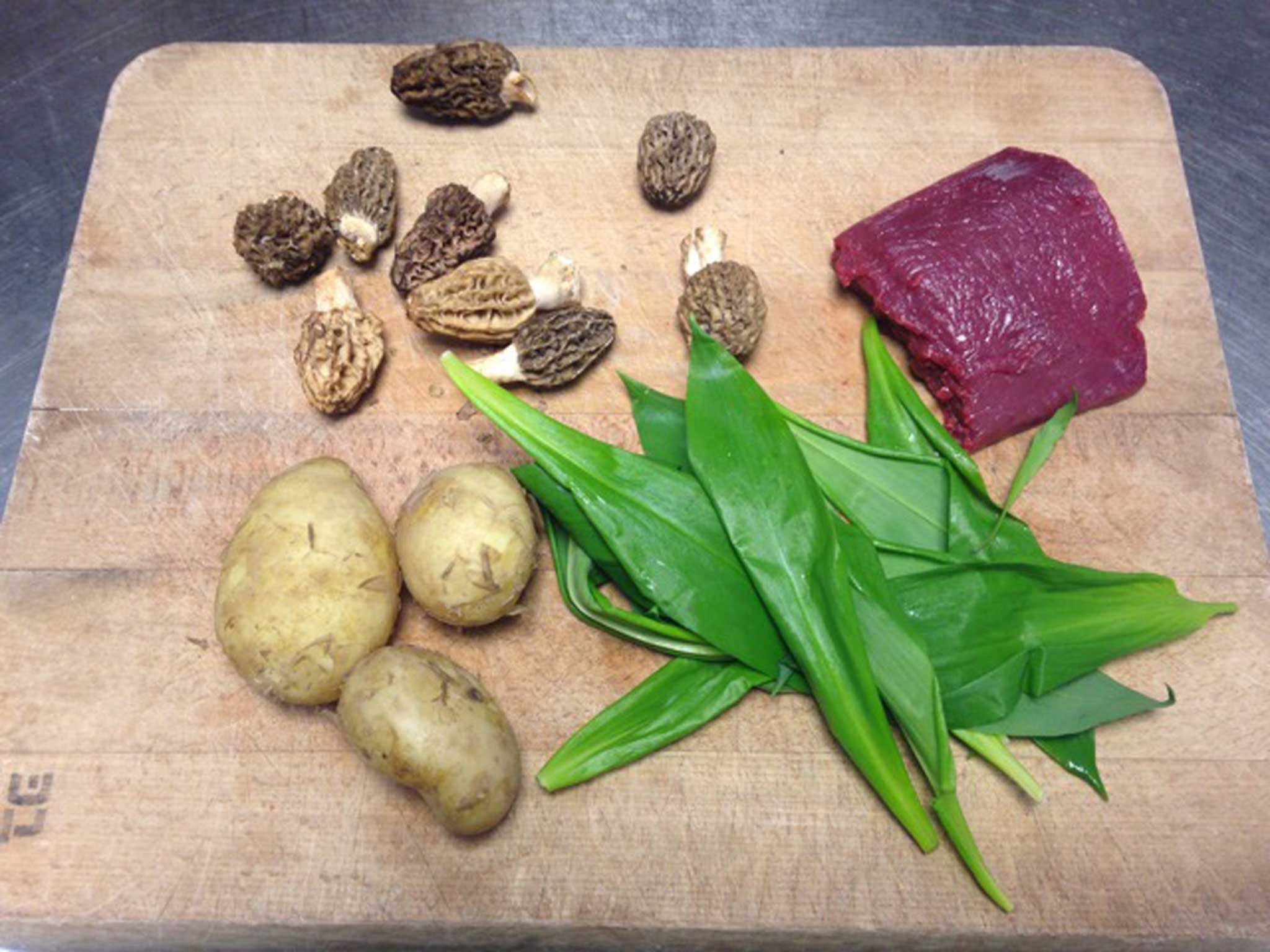
THE EAST
THE GUNTON ARMS
"When we opened The Gunton Arms, it was vital for us that it was welcoming to everyone, whether you were landed gentry or had just walked in from a hard day's graft in the fields," says Stuart Tattersall, chef-patron of the pub in Thorpe Market, North Norfolk. "It was also natural for me to translate my roots in British seasonal food into using ingredients I could monitor growing and roaming the area."
"This dish represents the essence of the Arms. Morels discovered by Martin Denny, my forager, were a must when he boasted he had just found some in nearby Swaffham; as was wild garlic, which carpets the surrounding woodland; and venison from the unspoilt Gunton parkland. I've used Jersey Royals as I wanted to celebrate their arrival, and their waxy, nutty flavour lends itself to this recipe."
Loin of Gunton fallow deer with morels, wild garlic and Jersey Royals
Serves 4
600g Jersey Royals
4 x 130g trimmed fallow-deer loin
200g morel mushrooms
40g wild garlic
Cover the potatoes with water, add a pinch of salt and bring to the boil. Simmer until tender.
Meanwhile, lightly oil the deer loin and season with salt and pepper. Place in a hot pan and cook roughly two minutes on each side. Set aside to rest for at least five minutes.
While it's resting, fry the morels in a bit of butter and a pinch of salt for a couple of minutes. Just before serving, add your wild garlic to the same pan just to wilt the leaves.
Slice the loin and place in the centre of the plate. Halve the Jersey Royals and arrange around the plate with the morels and wilted garlic, and finish with the venison juices.
Join our commenting forum
Join thought-provoking conversations, follow other Independent readers and see their replies
Comments